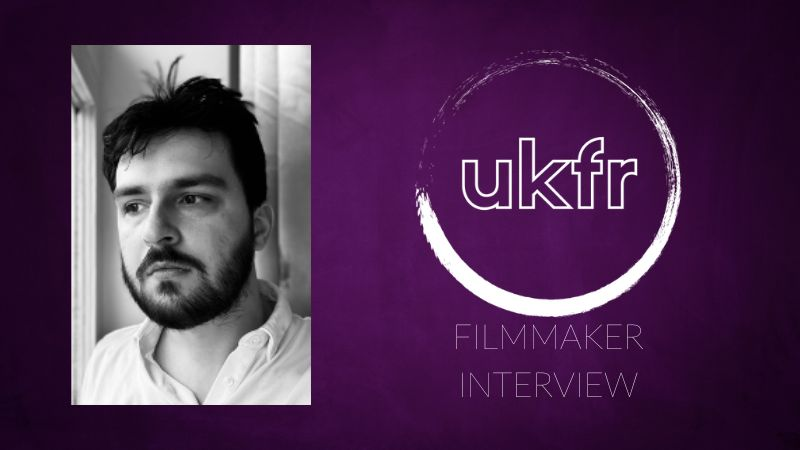
Filmmaker Interview by Chris Olson
Great to speak with you Cal. Where in the world are you right now?
The pleasure is all mine! I’m currently based in London, my favorite city in the world. I’ve lived here for so many years that it feels like my permanent home. London is truly a special hub for creatives—whether it’s filmmakers, actors, musicians, or artists. The city offers incredible networking opportunities and has a unique vibe that constantly inspires me.
You have a new short film in the festival circuit, SOMN. What’s the film about?
‘SOMN’ is about a boy trapped in a horrific, cyclical dream-like state with no hope of escape. It’s my most ambitious short yet, combining everything I’ve learned and studied over the years. The project was designed from the ground up to work specifically as a short film, making full use of the format. My hope is that viewers find ‘SOMN’ immersive, unsettling, and a compelling horror experience. It’s unconventional in its approach, but I believe it’s highly engaging.
Could you elaborate further on what you mean by ‘unconventional but still highly compelling?’
Absolutely. Without giving too much away, since ‘SOMN’ is meant to be open to interpretation, the film has a unique tempo and editing style that aims to emulate the disjointed nature of a dream. When we shot the film, we only had a one-page outline—a rough story that left room for improvisation. As a matter of fact, many of the scenes we initially planned either weren’t filmed or were cut in the editing process.
The final version of ‘SOMN’ is just over 4 minutes, including credits. Early cuts were closer to 7 minutes and included additional scenes that provided more context and backstory. However, I decided to trim anything that didn’t heighten the tension or felt too expository.
Much like real dreams, ‘SOMN’ jumps between scenes with little logic connecting them, yet it was crucial to maintain some sense of coherence to keep the audience engaged. The editing process was all about finding that balance. Sound design played a huge role in shaping the final edit, often sparking new ideas and directions for the film. We also did extensive test screenings to gather feedback and refine what worked.
Even in its brief runtime, ‘SOMN’ packs a lot in, and not everything is entirely clear by design. My hope is that it leaves viewers intrigued, making them ponder what they’ve just witnessed in the best possible way.
Why did you decide the make SOMN?
There were two main reasons. First, I believe horror is one of the best genres for a short film to stand out. Horror movies naturally draw an audience because we love the thrill of being scared, knowing we’re safe. Additionally, horror is budget-friendly and encourages creative problem-solving. I saw this as an opportunity to apply all the filmmaking techniques I’ve learned over the years and from my previous shorts to create a lean, intense horror film that keeps viewers engaged from start to finish.
The second reason is my frustration with modern horror, particularly horror shorts. To me, modern horror sacrifices so much atmosphere to exposition and cheap scares. A good horror premise can be ruined as everything is given a clear explanation and one final jump-scare or shocking reveal. ’SOMN’ draws heavily from 90s Japanese horror and the work of David Lynch. There’s a certain magic in how those films created an immersive, intoxicating atmosphere without relying on excessive exposition, jump scares, or gore. They focused on immersing the audience in a world that was bizarre and unsettling, which made the horror all the more effective. Often times, audiences would leave uncertain of what just occurred and they had to fill the intentional gaps with their own theories, which I think makes it all the more scary. I wanted to pay homage to that style, which is why ‘SOMN’ has a very specific visual aesthetic—a dirty, grainy look rather than the polished, clean imagery of modern films. Our colorist, Alexander Reinholdsson, did an incredible job capturing that atmosphere.
I’d also like to add that when it comes to more modern horror, David Robert Mitchell’s ‘It Follows’, released in 2014, really what I love in a horror film. A perfectly immersive, terrifying film that left you with more questions than answers by the end.
What challenges were there in getting this made and out there?
Without a doubt, the editing phase was the most challenging. The shooting and pre-production were so freeform that when I first looked at all the footage, especially in the initial edit, I thought, ‘I don’t know what any of this is supposed to mean or be.’ But that was part of the plan all along. Working on a super indie, low-budget project meant I had all these fantastic, disjointed pieces of a puzzle that needed to be put together.
The storyline went through several iterations, from a cursed protagonist to a more traditional haunted house narrative. Eventually, however, this experiment evolved into the current narrative—a kind of mundane cosmic horror. We don’t know why these events are happening to the main character, we don’t even fully understand what’s happening, or what the eponymous ‘SOMN’ is. In fact, we never really get to know who the main character is, as, small spoiler alert, they themselves don’t know who they are anymore, since it is revealed their whole identity was erased in the dream. This puts the audience in the same position as the protagonist: trapped in a repeating nightmare, unaware of how they got there or why it’s happening.
My hope is that, despite the ambiguity, the fear is palpable. Our lead actor, Karn Na Tarlang, did a tremendous job portraying a character who is vulnerable and terrified, which I believe will help audiences connect with his plight. I’m aware this approach might be controversial, but I stand by my decision to focus less on the bigger picture and more on the moment-to-moment experience. I’m confident that audiences will engage with the film and, hopefully, come up with their own theories about what’s really happening in ‘SOMN’.
The few spoken lines are also in Thai and the incomprehensible voice of the SOMN, which for a production made in England could perhaps prove divisive, but it is all subtitled of course in a style that compliments the short.
How have you evolved as a filmmaker since your previous film, Neon Heart?
The most significant evolution for me has been my focus on sound. In your fantastic review of Neon Heart, I appreciated the compliments on the visuals and acting—those are areas I’m passionate about, especially working with actors and helping them showcase their talents. However, the sound quality, particularly the poorly recorded dialogue, was a major downfall. That experience taught me that sound is just as crucial as the visuals and performances, if not more so.
This focus on sound was a driving force behind SOMN. We shot the film on an iPhone 14, partly out of convenience but also as a challenge to myself. I wanted to see how we could use framing, sound design, and editing to create a cinematic and gripping picture, even with the most minimal equipment.
Another key lesson has been the value of a talented crew and the importance of collaboration. Bringing skilled individuals onto a project is one of the most magical aspects of filmmaking, especially when they are given the freedom to contribute their own ideas and perspectives. As a director, my role is to ensure consistency so that the final product isn’t disjointed, but beyond that, I trust my crew completely. When everyone is connected to the material, the best ideas flow naturally, and I’m committed to fostering this creative environment in all my future projects.
You mentioned earlier all spoken lines are in Thai, why is that?
Well the main actor himself is Thai, so I wanted his lines to be in his home language as it was very important to feel authentic. This also works thematically, as I want what he goes through in the short to feel universal, plus my ethos as a filmmaker is to show diverse and underrepresented voices in all of my projects, to give a fresh perspective to audiences.
How can people get to see SOMN?
I’m currently planning the distribution strategy, as I want to ensure SOMN finds the right platform and audience. Rather than simply releasing it on YouTube, where it might get lost in the crowd, I’m focusing on entering the festival circuit first. My goal is to connect with short film distributors who can help bring SOMN to a wider audience. Online channels like ‘Alter’ could also be a great fit for the film.
We’ve put together a brief trailer to generate interest, and I’m hopeful that word of mouth will play a key role in building awareness for SOMN.
Why do you make movies?
I truly believe at this point it is what I am meant to do. I’ve always had such a passion for cinema and filmmaking, the creative process, collaborating on a set with like-minded individuals and how satisfying the challenges are. And more importantly , the fact that with movies, we can reach out to people. Like any art form, film can make us look within ourselves and help us develop as humans. I aim to do that as well, whichever the genre I work in, that those who watch will leave with something they didn’t have before seeing my films.
What’s next for you after this movie?
I’m currently working hard on ensuring SOMN is the best quality possible and we can show it at festivals so me and the team can create new experiences as soon as possible. Filmmaking is quite expensive, but I have enough interesting ideas that I hope will get financed so we can show them to the world.
#ChrisOlson #FilmmakerInterview



